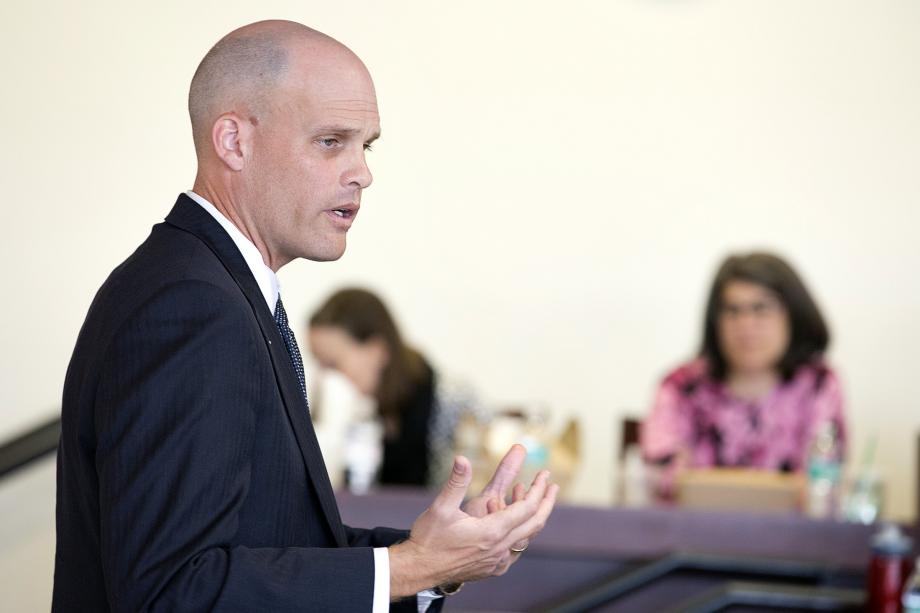The Clerk, The Thief, His Life As A Baker: Visiting Judge Tells Story of 1919 Supreme Court Leak

With all the prestige that comes from Supreme Court clerkships today, it might be hard to imagine a clerk resigning from the Court for his bakery business. But clerking in the early 1900s was not the career stepping-stone that it is today.
“The world of law clerks during this time was somewhat different than it is now,” Judge John Owens of the Ninth Circuit Court of Appeals told members of the Law School community recently, as part of the Edward H. Levi Distinguished Visiting Jurists Program. “Some justices had no clerks; if they had one, the clerk would play a largely administrative role.”
Still, something was amiss when Ashton Embry, clerk to Justice Joseph McKenna, left the Court in 1919 to become a full-time baker. His polite letter of resignation could not hide the legal drama brewing around his time at the Court. Just a few months after his resignation, the Department of Justice indicted him for sharing the Court’s decisions with Wall Street traders before the decisions were officially released. But what happened next is the stuff of novels: after the DOJ’s painstaking efforts to gather enough evidence against Embry and his co-conspirators, what could have been the first insider-trading conviction fell apart after a perfect storm of personalities and political events.
“When I was a law clerk at the Supreme Court, that year, for whatever reason, there were three separate novels about law clerks at the Supreme Court … [T]here was considerable focus on law clerks at that time,” Owens said as he shared his own research into Embry’s story with students. “So once I heard about [Embry’s story] I had to figure it out, as best as I could.”
This story offers insight into the role—and potential power—of a judicial clerk. Even in the early 1900s, Supreme Court clerks had unique access to market-moving court decisions. According to a memoir by former Secretary of State Dean Acheson, who clerked around the same time as Embry, “Each justice in those days had a docket book. One of the joys of being a law clerk was to open the book on Saturday afternoon and learn weeks ahead of the country what our masters had done.”
According to Owens, Embry probably indulged a bit too deeply in that particular joy—to the point of sharing court decisions with Wall Street insiders. Indeed, the DOJ built a solid case against Embry after it linked him with suspicious Wall Street stock transactions that seemed to predict the Court’s decision to void a major railroad patent in United States v. Southern Pacific Railroad.
John Hammond, the DOJ’s key source, helped build the case by recording the conspirators as they planned their next scheme. While the transcripts were enough to arrest Embry, the DOJ faced an unusual hurdle. How exactly did Embry and his co-conspirators break the law?
“They’re indicted. But for what?” Owens asked. “What’s the crime? This is before the Wall Street crash of 1929. The Securities and Exchange Commission doesn’t exist. Modern securities laws don’t exist. So what is it that they did?”
With no explicit prohibition on insider trading, the DOJ charged Embry with conspiring “to deprive the United States of its lawful right and duty of promulgating information in the way and at the time required by law and at departmental regulation.”
Embry’s defense team appealed these creative charges all the way up to the Supreme Court, the same court he was accused of betraying. But his case never went to trial and was eventually dismissed in 1929.
It is unclear why the case did not go further, but Owens suggested that Hammond’s personal troubles became a fatal liability for the DOJ. Around the same time as Embry’s case, the FBI was investigating Hammond, who was publically accused of conspiring with the Germans during World War I. J. Edgar Hoover personally wrote a lengthy dossier outlining Hammond’s false stories and unstable personality.
“At the same time that the justice department is trying to defend a criminal case at the Supreme Court, what else is happening? The FBI is writing a report saying that their source is terrible.” Owens explained that Hoover’s report completely discredited Hammond, who was nowhere to be found while the case and report were active.
With Hoover’s report and personnel changes in the DOJ under a new president, Embry’s case “just melted away,” Owens concluded.
Although Embry’s short-lived case is now almost a century old, Owens’s research puts an important spotlight on the role of judicial clerks today. The presentation, punctuated by laughter and bursts of surprise throughout, ended with many questions from the audience. Students were eager to learn more about Owens’s research and the professional responsibilities clerks owe to the courts they serve.
“It highlights the fact of how on the cutting edge you are as a clerk,” said Hope Silberstein, ’18. “You don’t think about the procedural context of clerking, that a couple of years out of law school you might have in your hands decisions that affect the whole country.”
Note: The talk was based on a paper by Owens: "The Clerk, The Thief, His Life as a Baker: Ashton Embry and the Supreme Court Leak Scandal of 1919," 95 Northwestern University Law Review 271 (2000).